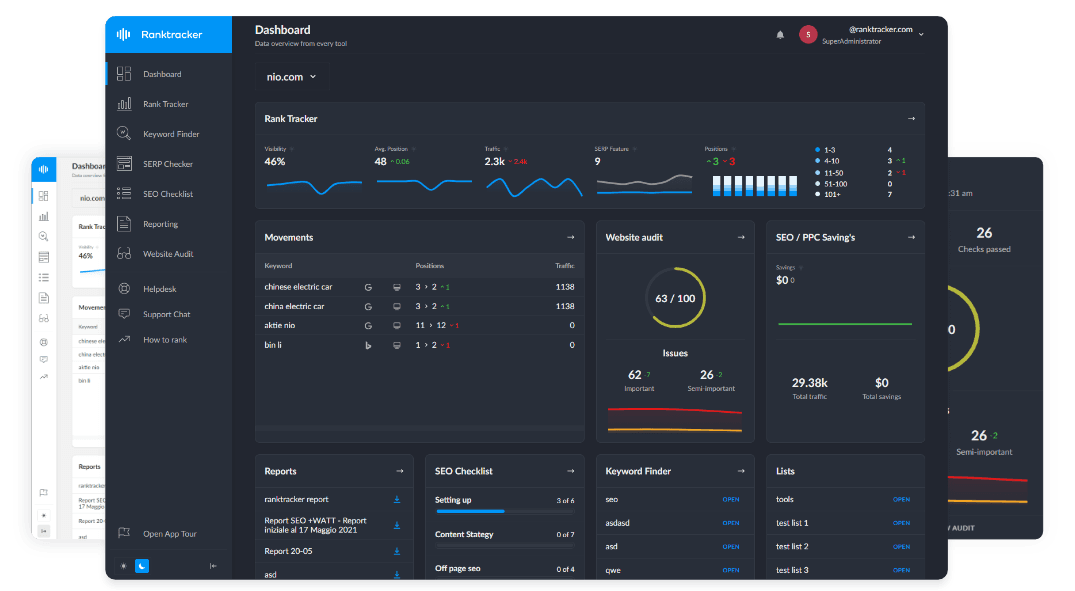Intro
Whether you're running a fitness club, coaching service, sports league, adventure park, or recreation facility, SEO (Search Engine Optimization) is essential to reach active individuals looking for their next sport, activity, or team. With Ranktracker’s robust SEO tools, sports and recreation brands can boost search visibility, increase memberships, and inspire community engagement.
1. Unique SEO Needs for the Sports & Recreation Industry
SEO in this space needs to capture high energy, regional relevance, and a sense of community. Your audience is often searching locally and with intent, whether to join a class, find a team, book an activity, or attend an event.
2. Keyword Research to Match Active Searchers
Your SEO efforts should focus on intent-based, local, and seasonal keywords:
-
"youth soccer leagues near me"
-
"best climbing gyms in [city]"
-
"summer sports camps for kids"
-
"outdoor fitness bootcamp"
Ranktracker’s Keyword Finder identifies these high-converting keywords so your facility or program stands out to the right crowd.
3. On-Page SEO That Highlights Offerings
Make sure your website is structured for search engines and active users:
-
Optimize meta titles/descriptions with your most valuable services and keywords
-
Use clear headings to separate different programs, schedules, or pricing
-
Include information-rich content like class descriptions, coach bios, safety protocols, and age group breakdowns
-
Use schema markup for events, schedules, pricing, and reviews
4. Local SEO for Foot Traffic and Registrations
Whether you offer a gym, court, camp, or tournament—local SEO is your gateway:
-
Optimize your Google Business Profile with hours, location, amenities, and photos
-
Collect and respond to reviews from members, athletes, and families
-
Use geo-targeted keywords like "basketball court rental in [city]"
-
Get listed in local directories, athletic forums, and community calendars
5. Content Marketing That Energizes and Converts
Content can help your business connect, educate, and convert visitors into players or participants:
-
Blog about training tips, nutrition, injury prevention, and local sports news
-
Post seasonal guides like "Top 5 Winter Sports Activities for Families"
-
Share success stories and testimonials from happy clients or team members
-
Provide downloadable schedules, workout plans, and waiver forms
6. Visual Optimization to Showcase Action
People want to see what they’re signing up for:
-
Post high-quality sports photos and videos of games, classes, or events
-
Use descriptive alt text (e.g., "kids swimming lessons in heated indoor pool")
-
Optimize file sizes for fast load speeds
-
Name images with SEO-friendly terms (e.g., "fitness-class-san-diego.jpg")
7. Build Backlinks from Trustworthy Recreation Sources
Get quality links from other authority sites in the sports or fitness space:
-
Collaborate with local sports bloggers or influencers
-
Get featured on city event listings or tourism websites
-
Join and get listed on national sports associations or training registries
-
Submit articles on fitness tips or youth development to relevant publications
Ranktracker’s Backlink Checker helps uncover valuable opportunities to grow your site's reputation.
8. Monitor SEO Performance to Stay Ahead
Use analytics to understand what works and where to improve:
-
Track keyword rankings with Ranktracker’s Rank Tracker
-
Use the Web Audit tool to identify technical or usability issues
-
Monitor traffic sources, registration form completions, bounce rates, and time on site to improve UX and conversions
Final Thoughts
For the sports and recreation industry, SEO is about more than just visibility—it’s about inspiring action, participation, and community. With Ranktracker’s end-to-end SEO platform, you can boost signups, increase visibility for programs and events, and become a trusted destination for active individuals. Start optimizing today to put your facility or service in the spotlight.

